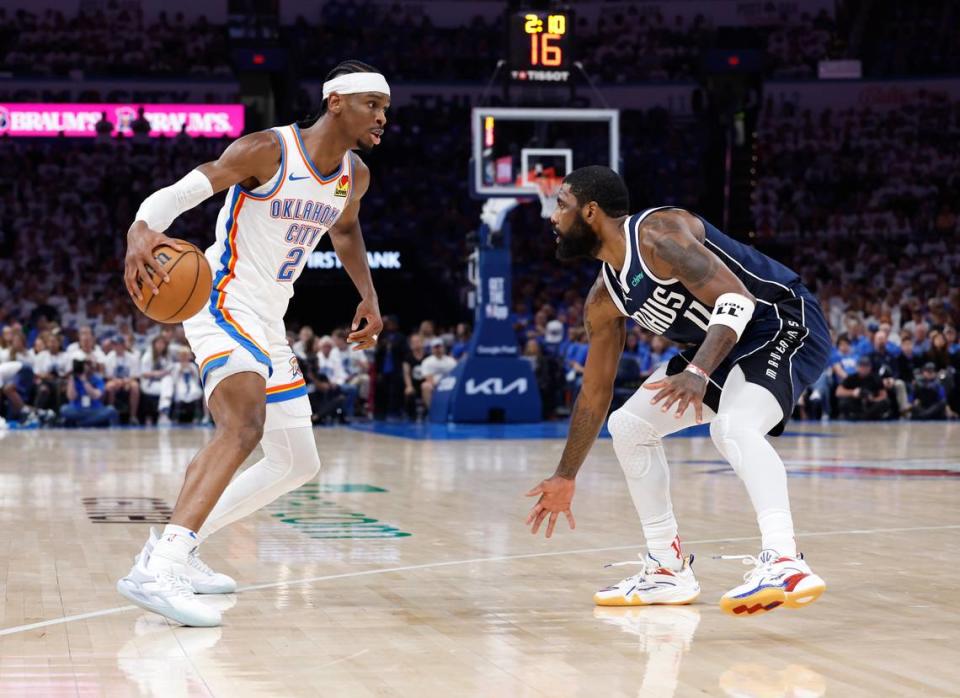Enjoy Steph’, Kyrie & Brunson; the NBA’s ‘Little Man’ era is being closed by giants

Watching the 6-foot-2 Jalen Brunson and Kyrie Irving torch NBA defenders with a display of old school basketball moves is now more captivating than ever because they are the ant men on a court full of Godzilla-like creations that don’t look real.
As the game has evolved we are watching giants exhibit skills that previously belonged exclusively to the little guys. It’s what made the 6-foot-9 Magic Johnson and Larry Bird stand out.
Today, 7-footers hit 3-pointers like Steph Curry. They can pass it like Chris Paul. They can dribble up the floor like Trae Young.
“Stephen Curry is special and the the NBA tried that era for a while because it worked, but the era of Nikola Jokic and Karl-Anthony Towns is here. The Golden State era is over,” former Dallas Mavericks forward Pete Mickeal said this week in a phone interview.
Mickeal is 46 now, and he has been around basketball since he was about six months. Played at the University of Cincinnati. Drafted by the Mavericks in the second round in 2000. Didn’t really stick in the NBA, but played overseas until he retired in 2014.
Since then he’s worked for NBA franchises, including the Timberwolves, and now runs the NTX International Combine, held May 8 - 10 in Duncanville. The concept behind this NBA-approved combine is to prepare a young man for pro ball, be it in the NBA or overseas.
This includes telling the person who is essentially a kid what they may not want to hear. And that might be, “Can you grow a few more inches?”
“We change what we tell them based on what scouts are looking for, and everything right now is analytics,” Mickeal said. “If you go to an NBA team’s front office now, they may have five scouts, and two of them are analytics guys. And those guys make more than the rest of the scouts combined.
“Just look at what the Timberwolves are doing. They are very analytics driven. They put three 7-footers on the floor, and look at the success they’re having. Everything now is about length.”
The Warriors assembled a dynasty anchored around the 6-foot-3 Steph Curry, who was a combination of ball handling and outside shooting that was as good as any player who ever lived. The Warriors were a center-less team, and they dominated the league.
That style was emulated, just not successfully. Because finding Atlantis, the real one as opposed to the resort, is easier than unearthing another Steph.
So, now teams have leaned into the trees. The average height of today’s NBA player is roughly 6-foot-5, two inches shorter than the biggest figure in its history, but this number is trending towards the heavens.
In the 2023 NBA Draft eight players who measured shorter than 6-foot-5 were selected. According to a variety of NBA mock drafts for the class of 2024, expect about eight to 10 players shorter than 6-foot-5 to be picked.
The tall guy who can do the same thing as the small guy is always the better option. Hard to teach height, and wingspan.
Kevin Durant, LeBron James, Jayson Tatum, Nikola Jokic, Giannis Antetokounmpo, Damontas Sabonis, Luka Doncic, etc. have all reset the norms for the player who is 6-foot-8 and above.
And then there is San Antonio Spurs rookie Victory Webmanyama, all 7-foot-4 of him. He’s a guard/shooting guard/power forward/center.
If you are not a legit 6-foot-2, you can almost forget it. The measurement matters.
“If you go to the NBA combine in Chicago and you measure shorter than what you were listed in college, it’s an immediate red flag,” Mickeal said. “Again, go back to the Timberwolves.”
With the new success of the Minnesota Timberwolves and their lineup of sequoia trees, the small guy now is 6-foot-5. (FYI: The average height of a male is 5-foot-9.)
Karl-Anthony Towns is a 7-footer, who can dribble and make 3-pointers. Naz Reid is 6-foot-9, who can make 3-pointers. Jaden McDaniels is 6-foot-9, and he can take 3-pointers.
And then there is center Rudy Gobert. The NBA Defensive Player of the Year is the 7-footer whose offensive game makes Mark Eaton look like Michael Jordan. (That’s an old-school NBA reference; Eaton was the human sky scraper who had no offense).
For the last few years, the top level of NCAA programs have seen this trend of NBA teams leaning into height, and warned players. Those warnings, amid a host of others, are usually ignored as young men who aspire to make six and seven figures playing pro ball see what they choose.
The evolution has not hit the NCAA level yet, and it may not. The NCAA basketball game still looks like a basketball game, where short and tall co-exist, and thrive. The point guard can be 5-foot-11. The shooting guard can be 6-foot-4. The small forward is 6-foot-6. The power forward is 6-8. The center is 6-foot-10.
The NBA is increasingly a game of men who look like something out of Jurassic Park, where players like Kyrie, Steph and Brunson are the ones on the edge of extinction.

